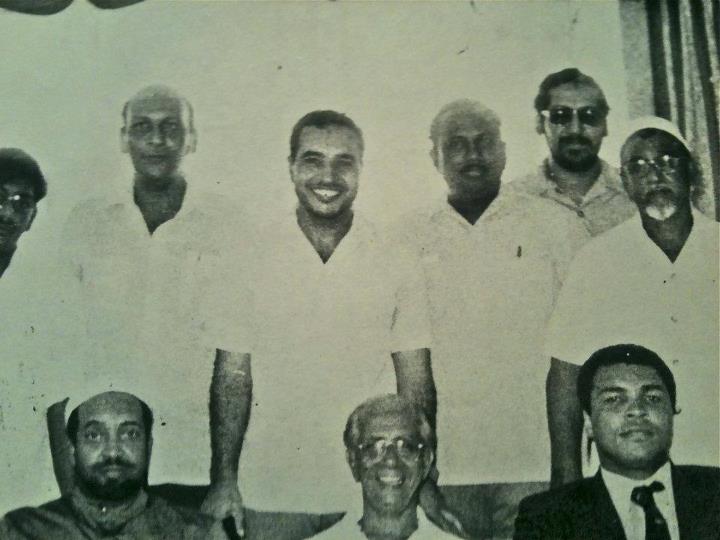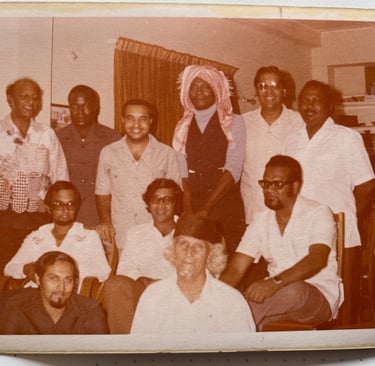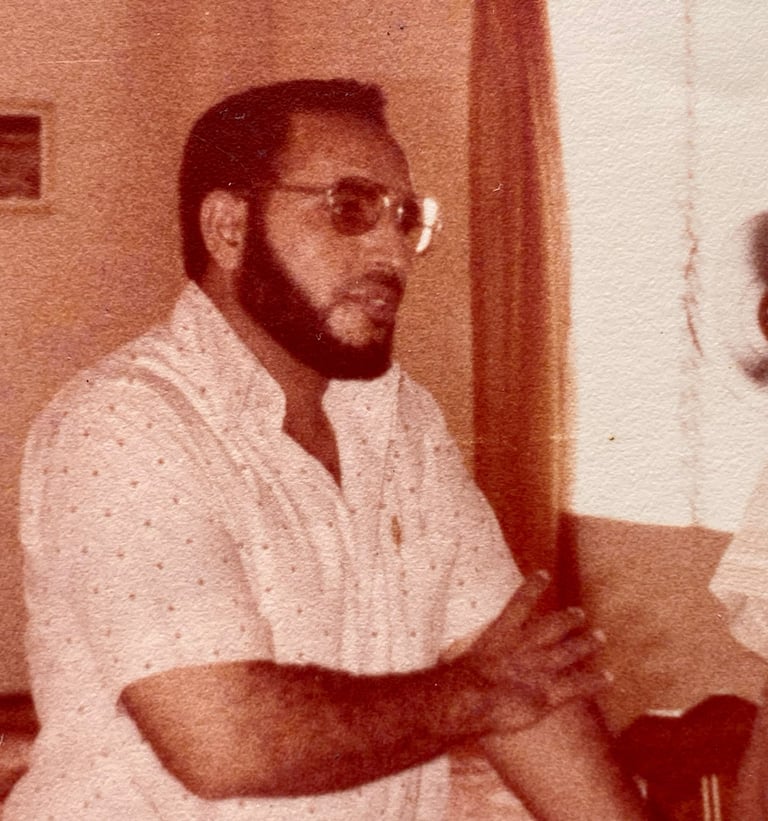

ABOUT



Ustadh Ahmad Ehwas

Ustadh Ahmad Ehwas was born in 1938 in Qaminis, a village 50 kilometers south of Benghazi, Libya. His father, Hajj Ibrahim Az-Zarruq Ehwas, was a merchant and as such Ustadh Ahmad was raised in a middle-class family. Sometime in 1947, Ustadh Ahmad began attending Jardinah Primary School. During the four years he spent there he began attending evenings and weekends Islamic studies classes with Shaykh Faraj Obeidallah Al-Barghathi and Shaykh Ali Al-Qalal, a respected jurist and an influential local imam. In the early 1950’s Ustadh Ahmad was enrolled in Al-Abyar boarding school and eventually Benghazi Secondary School.
His personal economic circumstances compelled him to work during the day in order for him to study at night. It was during this period in time that he began to participate in the activities of the Muslim Brotherhood - Al-Ikwan Al-Muslimoon. His friends say that his exposure to members of the group inspired him to become committed to the practical ideals of the Islamic revivalist movement.
In 1960, Ustadh Ahmad joined the military academy in Benghazi and graduated top of his class and earned the rank of second lieutenant. Ibrahim Abdulaziz Sahad, the former Libyan Ambassador to Argentina, joined the academy a few years after Ustadh Ahmad. Ustadh Sahad, now a member of the High Council for the State of Libya, said he and Ustadh Ahmad struck up a close friendship.
Ustadh Sahad was surprised when he learned that Ustadh Ahmad was already married by the time he was enrolled in the academy. He recalled that even at that time Ustadh Ahmad was remarkably disciplined.
In a lengthy interview for this documentation project, Ustadh Sahad said that Ustadh Ahmad “was different from the previous Sergeant Majors. He never lost his temper with the cadets. I learned from Ehwas that to be a leader, especially a military leader, it's not necessary to be rigid. Firm, yes, but balanced. He was a religious person. Of course, we all know we have to do prayers on time, but in the military, sometimes the prayer times would conflict and we had to delay our prayers. I would notice that Ahmad, the first thing he does after he comes from training, is that he will go and perform his prayers. He did not say much about da'wah or calling to Allah, but you could see in his manner that he was doing just that.”


After graduating from the military academy, Ustadh Ahmad was appointed to the field of engineering corps and stationed at the Garyounis military base. Because Libya was an ally of the West at the time, Ustadh Ahmad was selected to participate in a training course at the Army Corps of Engineers in Norfolk, Virginia in 1963.
He also later participated in a training course in Britain. He returned to Garyounis army base and was assigned an instructor at its Military college while also serving as a commander of Al-Rahba Company in Tripoli.
In 1965, Muammar Gaddafi was a Lieutenant and Ustadh Ahmad became aware of him. In an interview that Ustadh Ahmad gave when he joined the National Front for the Salvation of Libya, he said, “I knew Muammar Gaddafi as a student at the Military College in 1965 when I was teaching there. I knew him to be odd in his thinking and his actions.”
When Gaddafi emerged as the leader of the September 1969 coup that toppled King Muhammad Idris bin Muhammad al-Mahdi as-Senussi, Ustadh Ahmad refused to send a telegram of support to Gaddafi “Bouminyar” and later said “it was difficult for me to declare my opinion of him during the spontaneous support of the masses of our people. I chose instead to serve my religion and my nation from wherever I am sent.”
Ustadh Ibrahim Sahad said that as a consequence of his refusal to congratulate Gaddafi, “Ahmad Ehwas was imprisoned in Tripoli. When they released me, they asked me to stay at home. Finally they sent most of the army officers either to work in civilian jobs or into the diplomatic corps. Ahmad Ehwas and myself and others were drafted into the diplomatic corps in 1970 and dispatched to work in the embassies abroad. It was a type of exile to keep us away from the country.”
Ustadh Ahmad’s first diplomatic appointment was to the Libyan embassy in Copenhagen in February 1970. During his time in Copenhagen, he strengthened the Muslim community by helping to establish the Islamic Cultural Center, the first recognized mosque not just in Copenhagen, but in all of Scandinavia.
Continued below...
In 1972, Ustadh Ahmad was transferred to Mogadishu, Somalia. His wife, Hajjah Fatima Dawood, described their personal living experience as being “extremely difficult.” Nevertheless, Ustadh Ahmad began building relationships between prominent scholars and du’at (preachers) in an atmosphere of intense repression by Maj. General Mohammed Said Barre who, like Gaddafi, had seized power in October 1969.
Unable to contain Ustadh Ahmad, Gaddafi had him transferred to Aden, Yemen at the beginning of 1973. Again, he inserted himself in the Yemeni unity talks, mediating between warring factions and was credited with the release of many political prisoners.
In late 1975, Ustadh Ahmad attempted to return home to join the growing resistance against Gaddafi, but he was quickly dispatched to the Libyan embassy in Malaysia in June 1976 to serve as an advisor on religious affairs.
Still living out of his suitcase, he was posted to the newly established embassy in Georgetown, Guyana. He arrived in February 1977 on the eve of 12 Rabi’ Al-Awwal when Guyanese Muslims were preparing to observe the Mawlid commemorating the birth of the Prophet Muhammad ﷺ.
If Gaddafi meant Guyana to be a sort of banishment to a distant outpost some 8,400 kilometers from Tripoli, Ustadh Ahmad was unfazed by the challenges he would face in Guyana. Ustadh Ahmad would spend a total of four years in Guyana.
In January 1981, he learned that Gaddafi’s henchmen had him in their scopes. Gaddafi had ordered the assassination of Libyan dissidents at home and abroad that he believed were plotting against him. Ustadh Ahmad, his wife - Hajjah Fatimah - and their adopted son, Asad left Guyana in the shadow of darkness, never to return.


Ustadh Ahmad became the second high profile Libyan diplomat to openly announce he was joining The National Front for the Salvation of Libya. The first was Mohammed Yousef el-Magariaf, the former Libyan ambassador to India. During an attempt to remove Gaddafi from power in May 1984, Ustadh Ahmad was killed by security forces inside Libya. His body was never turned over to his family and no one knows where his remains are buried.
Today, he is hailed as a hero of the struggle for freedom from tyranny in Libya and a research academy has been named after him.
The Guyana Islamic Trust has named an auditorium at the Guyana Islamic Institute in his name and a generous philanthropist who has never personally met Ustadh Ahmad, has disbursed over $80 million Guyana dollars of scholarships to deserving Guyanese students in his name.
(Nazim Baksh, Executive Producer)
Join Mailing List
To receive updates on new content, please register for our notification service. Your subscription ensures timely information about the latest additions and insights from Ustadh Ahmad Ehwas' teachings. We value your interest and commitment to continuous learning.

